Your worries about 70-465 exam completely no more exist, because GreatExam is here to serves as a guide to help you pass the exam. GreatExam offers the latest 70-465 PDF and VCE dumps with the new version VCE player for free download. All the 70-465 exam questions and answers are the latest and cover every aspect of 70-465 exam. It 100% ensures you pass the exam without any doubt.
QUESTION 121
You are the new database administrator for a SQL Server 2014 instance.
You conduct an assessment on the instance and determine that the auto create statistics setting on the database named DB1 has been turned off.
You see no evidence that any maintenance has been occurring.
You want to set up monitoring to see if query performance is being affected.
You need to set up a monitoring process that will capture any cases where statistics could have been useful if they existed.
What should you do?
A. Create a SQL Server Agent job to execute DBCC SHOWSTATISTICS on each of the primary key columns in the database.
B. Use the missing_column_statistics extended event.
C. Query the sys.statistics system view to see all cases where the statistics were last needed.
D. Write a query using the sys.dm_db_missing_index_group_stats DMV Joining to sys.indexes, filtering on is_hypothetical.
Answer: B
Explanation:
The Missing Column Statistics event class indicates that column statistics that could have been useful for the optimizer are not available.
By monitoring the Missing Column Statistics event class, you can determine if there are statistics missing for a column used by a query.
This can cause the optimizer to choose a less efficient query plan than expected.
QUESTION 122
You have two databases named DB1 and DB2 that are located on the same server.
You plan to create a stored procedure named SProc1 in DB1.
SProc1 will query a table named Table2 in DB2.
You need to recommend a solution to ensure that SProc1 can access Table2 without granting users direct access to Table2.
What should you include in the recommendation? More than one answer choice may achieve the goal. Select the BEST answer.
A. Contained databases
B. Application roles
C. Cross-database ownership chaining
D. Digital certificates
Answer: B
Explanation:
An application role is a database principal that enables an application to run with its own, user-like permissions.
You can use application roles to enable access to specific data to only those users who connect through a particular application.
Unlike database roles, application roles contain no members and are inactive by default.
QUESTION 123
You have a server named Server1 that has 16 processors.
You plan to deploy multiple instances of SQL Server 2014 to Server1.
You need to recommend a method to allocate processors to each instance.
What should you include in the recommendation? More than one answer choice may achieve the goal. Select the BEST answer.
A. Processor affinity
B. Windows System Resource Manager (WSRM)
C. Max Degree of Parallelism
D. Resource Governor
Answer: A
Explanation:
CPU affinity management through Windows System Resource Manager is not recommended for SQL Server multi-instance management. Instead, use the processor affinity settings in SQL Server.
QUESTION 124
You have two SQL Server 2014 instances named SQLDev and SQLProd.
You plan to create a new database on SQLProd that will use SQL Server Authentication.
You need to ensure that when the new database is copied from SQLProd to SQLDev, users can connect to the database on SQLDev even if they do not have a login on the SQLDev instance.
What should you use? More than one answer choice may achieve the goal. Select the BEST answer.
A. Triggers
B. Contained database
C. SQL Server Analysis Services (SSAS) scripts
D. Extended Events
E. SQL Server Integration Services (SSIS) scripts
Answer: B
Explanation:
A fully contained database includes all the settings and metadata required to define the database and has no configuration dependencies on the instance of the SQL Server Database Engine where the database is installed.
QUESTION 125
You have a query that is used by a reporting dashboard.
Users report that the query sometimes takes a long time to run.
You need to recommend a solution to identify what is causing the issue.
What should you recommend? More than one answer choice may achieve the goal. Select the BEST answer.
A. Set the blocked process threshold, and then run SQL Server Profiler.
B. Set the blocked process threshold, and then create an alert.
C. Enable trace flag 1204, and then create an alert.
D. Create a job that queries the sys.dm_os_waiting_tasks dynamic management view.
Answer: B
Explanation:
Step 1: Turn on the blocked process report.
This will look for any blocking taking 20 seconds or longer.
–Make sure you don’t have any pending changes
SELECT *
FROM sys.configurations
WHERE value <> value_in_use;
GO
exec sp_configure ‘show advanced options’, 1;
GO
RECONFIGURE
GO
exec sp_configure ‘blocked process threshold (s)’, 20;
GO
RECONFIGURE
GO
Step 2: Set up a trace to capture the blocked process report. Run it as a server side trace.
QUESTION 126
You are troubleshooting an application that runs a query.
The application frequently causes deadlocks.
You need to identify the isolation level used by the query when a deadlock occurs.
What should you do? More than one answer choice may achieve the goal. Select the BEST answer.
A. Query the sys.dm_exec_requests dynamic management view.
B. Create a trace in SQL Server Profiler that contains the Deadlock graph event.
C. Query the sys.dm_exec_sessions dynamic management view.
D. Enable trace flag 1222, and then view the SQL Server error log.
Answer: C
Explanation:
– sys.dm_exec_sessions
Returns one row per authenticated session on SQL Server. sys.dm_exec_sessions is a server-scope view that shows information about all active user connections and internal tasks.
Include the column:
transaction_isolation_level
smallint
Transaction isolation level of the session.
0 = Unspecified
1 = ReadUncomitted
2 = ReadCommitted
3 = Repeatable
4 = Serializable
5 = Snapshot
Is not nullable.
QUESTION 127
You administer a SQL Server 2014 instance.
Users report that the SQL Server has seemed slow today.
A large database was being restored for much of the day, which could be causing issues.
You want to write a query of the system views that will report the following:
– Number of users that have a connection to the server
– Whether a user’s connection is active
– Whether any connections are blocked
– What queries are being executed
– Whether the database restore is still executing and, if it is, what percentage of the restore is complete.
Which system objects should you use in your query to best achieve this task?
A. sys.dm_exec_requests, sys.dm_exec_sessions, sys.objects
B. sys.dm_exec_sessions, sys.dm_exec_query_stats, sys.dm_exec_query_text,sys.objects
C. sys.sysprocesses, sys.dm_exec_query_text, sys.objects
D. sys.dm_exec_requests, sys.dm_exec_sessions, sys.dm_exec_query_text
Answer: D
Explanation:
– sys.dm_exec_requests
Returns information about each request that is executing within SQL Server.
– sys.dm_exec_sessions
Returns one row per authenticated session on SQL Server. sys.dm_exec_sessions is a server-scope view that shows information about all active user connections and internal tasks.
This information includes client version, client program name, client login time, login user, current session setting, and more.
– sys.dm_exec_query_text
Returns the text of the SQL batch that is identified by the specified sql_handle.
Incorrect:
– sys.dm_exec_query_stats
Returns aggregate performance statistics for cached query plans in SQL Server.
The view contains one row per query statement within the cached plan, and the lifetime of the rows are tied to the plan itself.
– sys.objects
Contains a row for each user-defined, schema-scoped object that is created within a database.
QUESTION 128
You have a database hosted on SQL Server 2012 R2.
The database contains 5 million rows.
You need to recommend a repeatable method to migrate the database to SQL Azure.
Which method should you recommend? More than one answer choice may achieve the goal. Select the BEST answer.
A. Create a SQL Server Integration Services (SSIS) package, and then run the package.
B. Back up the database, and then restore the database.
C. Extract a data-tier application, and then import the application.
D. Generate scripts to create all of the all database objects and all of the data, and then execute
the scripts by using SQL Azure.
Answer: A
Explanation:
SQL Server Integration Services
Most flexibility
Data Transfer Efficiency: Good
– SSIS can be used to perform a broad range of data migration tasks.
SSIS provides support for complex workflow and data transformation between the source and destination. It is a good choice to transfer of data for databases that require many changes to work on Microsoft Azure SQL Database.
You can use SSIS data transfer packages with another mechanism for transferring the database schema, such as a Data-tier Application package.
Incorrect:
Not D: Generate Scripts Wizard
Has explicit option for Azure SQL Database scripts generation Data Transfer Efficiency: Poor
Good for smaller database
– Using the Generate Scripts wizard to migrate a SQL Server database to Azure SQL Database should be limited to:
Teams who have experience with the wizard.
Migrating simple databases that need few schema changes to run on Azure SQL Database.
The scripts generated from the source database can be modified before being used to create the new version of the database on Azure SQL Database, but using a database project in the SQL Server Data Tools has richer support for making schema changes.
Migrating small databases that do not have much data.
The wizard generates scripts that use insert statements instead of bulk copies to transfer the data. The insert statements can be throttled when the tables contain too much data, and are not as fast as bulk copies.
QUESTION 129
You have a SQL Server 2014 database named DB1.
You plan to import a large number of records from a SQL Azure database to DB1.
You need to recommend a solution to minimize the amount of space used in the transaction log during the import operation.
What should you include in the recommendation?
A. The bulk-logged recovery model
B. The full recovery model
C. A new partitioned table
D. A new log file
E. A new file group
Answer: A
Explanation:
Compared to the full recovery model, which fully logs all transactions, the bulk-logged recovery model minimally logs bulk operations, although fully logging other transactions.
The bulk-logged recovery model protects against media failure and, for bulk operations, provides the best performance and least log space usage.
Note:
The bulk-logged recovery model is a special-purpose recovery model that should be used only intermittently to improve the performance of certain large-scale bulk operations, such as bulk imports of large amounts of data.
QUESTION 130
You have a server named Server1 that has 2 processors.
You plan to deploy multiple instances of SQL Server 2014 to Server1.
Each instance will have multiple databases.
You need to recommend a method to allocate processor time to each database.
What should you include in the recommendation? More than one answer choice may achieve the goal. Select the BEST answer.
A. Resource Governor
B. Max Degree of Parallelism
C. Windows System Resource Manager (WSRM)
D. Processor affinity
Answer: A
Explanation:
SQL Server Resource Governor is a feature than you can use to manage SQL Server workload and system resource consumption.
Resource Governor enables you to specify limits on the amount of CPU, physical IO, and memory that incoming application requests can use.
Incorrect:
D: PROCESS AFFINITY
Enables hardware threads to be associated with CPUs.
QUESTION 131
You have a SQL Server 2014 environment That includes four servers.
The servers are configured as shown in the following table.
You plan to configure Policy-Based Management to enforce the following rules:
– On Server1, enable SQL Server password policies and enable the default trace.
– On Server3, ensure that the names of user-defined stored procedures begin with the prefix “usp_” and ensure that all databases use a case-sensitive collation.
You need to recommend which server you must configure as a Central Management Server. Which server should you recommend? (Each correct answer presents a complete solution. Choose all that apply.)
A. Server1
B. Server2
C. Server3
D. Seiver4
Answer: AC
Explanation:
Need Standard or Enterprise edition of SQL Server.
QUESTION 132
You are the administrator for a SQL Server 2014 instance that stores the data for an online transaction processing sales system.
The company takes full backups every week; differential backups on the days with no full backups; and hourly transaction backups.
These backups are stored on a backup server in the company’s data center.
Every week, the company places the full backup on a tape and sends it to a third-party backup storage system.
The company is worried that a disaster might occur that could destroy their computer center and cause them to lose orders.
You need to determine the best method for providing the smallest amount of data loss and downtime without leasing or purchasing additional physical locations.
What should you do? More than one answer choice may achieve the goal. Select the BEST answer.
A. Set up SQL Server Always On with a SQL Azure database as a replica.
B. Set up SQL Server Always On by using a SQL Server on a Windows Azure Virtual Machine.
C. Put the differential backup on tape and send it to the third-party backup storage system.
D. Use the Microsoft SQL Server Backup to Microsoft Windows Azure Tool to direct all backups to a different geographical location.
Answer: D
Explanation:
SQL Server 2012 was the first version to provide the ability to back up databases to the Cloud, and SQL Server 2014 improves on the process.
Microsoft SQL Server Backup to Windows Azure Tool enables backup to Windows Azure Blob Storage and encrypts and compresses SQL Server backups stored locally or in the cloud.
QUESTION 133
You need to recommend a backup process for data warehouse database.
The solution must meet the following requirements:
– Ensure that if a hardware failure occurs, you can bring the database online without losing more than 24 hours of transactions.
– Minimize the amount of administrative effort required to restore any lost data.
– Minimize the space used by transaction logs.
What should you include in the recommendation? To answer, move the appropriate actions from the list of actions to the answer area and arrange them in the correct order.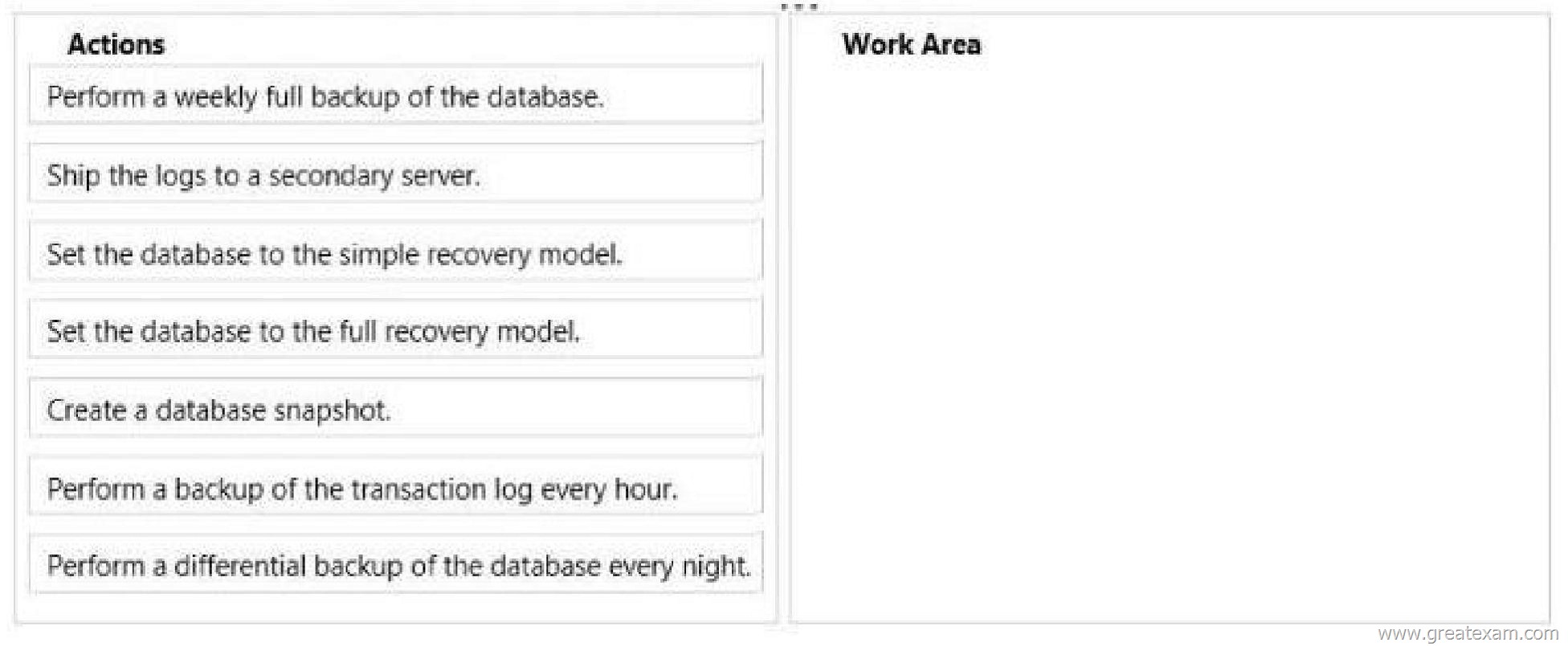
Answer: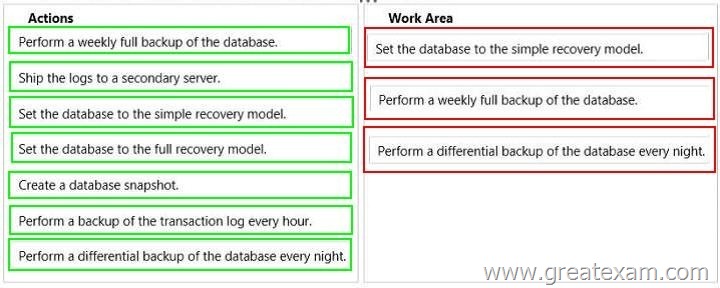
Explanation:
Box 1: Set the database to the simple recovery model.
Box 2: Perform a weekly full backup of the database.
Box 3: Perform a differential backup of the database every night.
Note:
– Simple recovery model
No log backups.
– Full recovery model
Requires log backups
QUESTION 134
You plan to deploy a database to SQL Azure.
You must create two tables named Table 1 and Table 2 that will have the following specifications:
– Table1 will contain a date column named Column1 that will contain a null value approximately 80 percent of the time.
– Table2 will contain a column named Column2 which is the product of two other columns in Table2.
Both Table1 and Table2 will contain over one million rows.
You need to recommend which options must be defined for the columns.
The solution must minimize the time it takes to retrieve data from the tables.
Which options should you recommend? To answer, drag the appropriate options to the correct column in the answer area.
Answer:
Explanation:
– Sparse columns are ordinary columns that have an optimized storage for null values.
Sparse columns reduce the space requirements for null values at the cost of more overhead to retrieve nonnull values.
Consider using sparse columns when the space saved is at least 20 percent to 40 percent.
– A Persisted column would be faster to retrieve.
– A computed column is computed from an expression that can use other columns in the same table. The expression can be a noncomputed column name, constant, function, and any combination of these connected by one or more operators.
Unless otherwise specified, computed columns are virtual columns that are not physically stored in the table. Their values are recalculated every time they are referenced in a query.
The Database Engine uses the PERSISTED keyword in the CREATE TABLE and ALTER TABLE statements to physically store computed columns in the table.
Their values are updated when any columns that are part of their calculation change.
QUESTION 135
You use SQL Server 2014.
You create a table within a database by using the following DDL: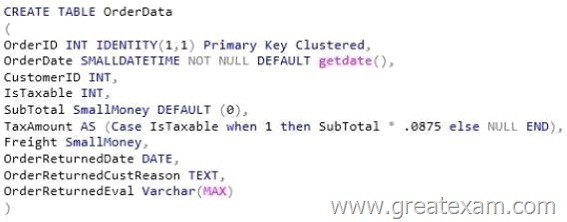
The following table illustrates a representative sample of data: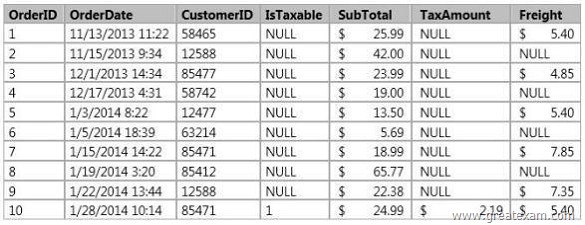
The system is expected to handle 50 million orders a month over the next five years.
You have been instructed by your Team Lead to follow best practices for storage and performance in the utilization of SPARSE columns.
Which columns should you designate as SPARSE? To answer, mark each column as SPARSE or NOT SPARSE in the answer area.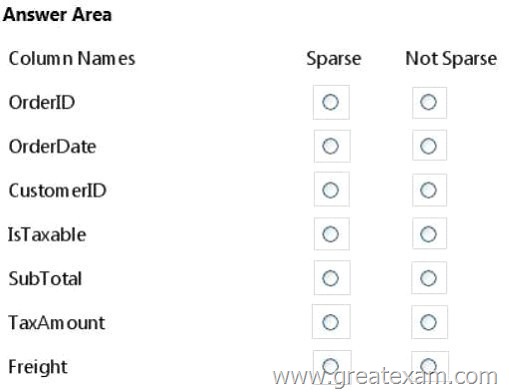
Answer:
Explanation:
Sparse columns are ordinary columns that have an optimized storage for null values.
Sparse columns reduce the space requirements for null values at the cost of more overhead to retrieve nonnull values.
Consider using sparse columns when the space saved is at least 20 percent to 40 percent.
QUESTION 136
You use SQL Server 2014.
You need to create a single object that inserts a provided value into Table1, and then returns a count of the records in Table1.
Develop the solution by selecting and arranging the required code blocks in the correct order.
You may not need all of the code blocks.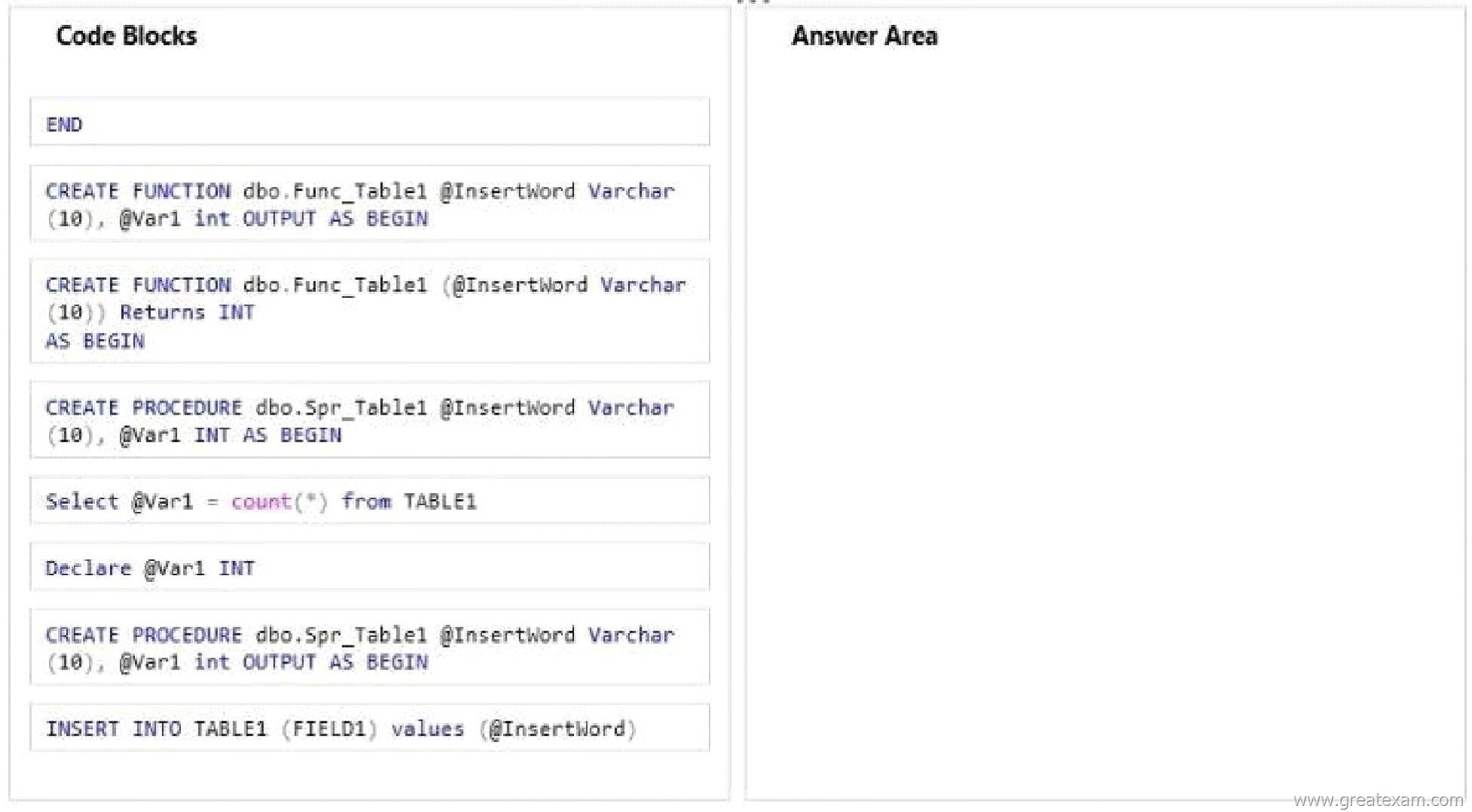
Answer:
QUESTION 137
You plan to install two SQL Server 2014 environments named Environment1 and Environment2.
Your company identifies the following availability requirements for each environment:
– Environment1 must have mirroring with automatic failover implemented.
– Environment2 must have Always On with automatic failover implemented.
You need to identify the minimum number of SQL Server 2014 servers that must be deployed to each environment to ensure that all data remains available if a physical server fails.
How many servers should you identify? To answer, drag the appropriate number to the correct environment in the answer area.
Answer:
QUESTION 138
You are the senior database administrator at Contoso, Ltd.
You manage a SQL Server 2014 Instance, with multiple databases used for reporting.
You have recently hired a junior database administrator.
You want this person to be able to view the database structures on the server, but you do not want him or her to be able to make changes or see the data in the tables.
The new hire’s login credentials are as follows:
– Login name: JFree
– Password: Jx672$qse
You want the new hire to be required to change his password on his next login.
The code that is produced should execute no matter the initial database context in which it is started.
You need to write the code required to give the new hire only the desired access, using the smallest number of steps.
Develop the solution by selecting and arranging the required code blocks in the correct order.
You may not need all of the code blocks.
Answer: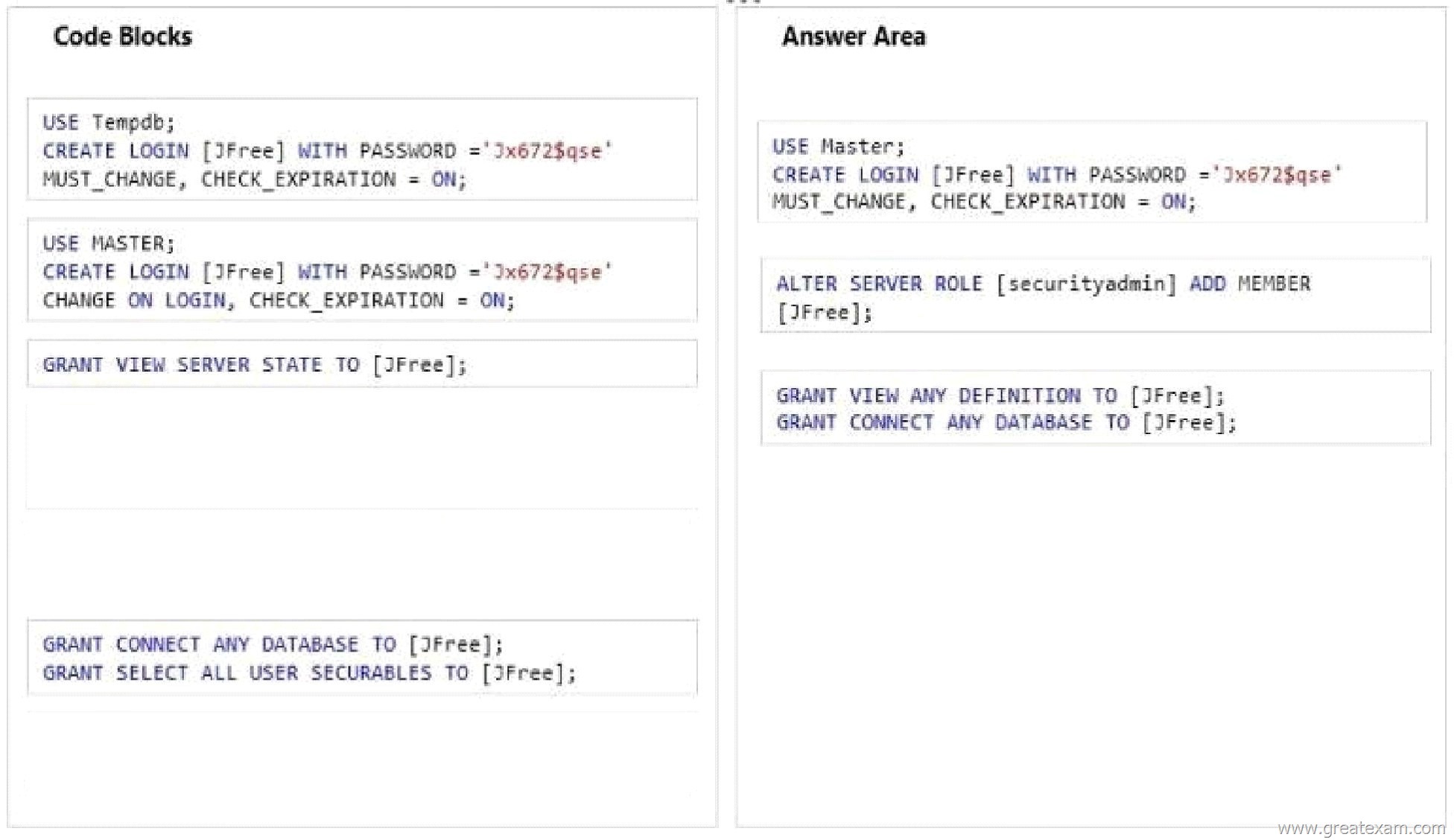
Explanation:
– MUST_CHANGE
Applies to: SQL Server 2008 through SQL Server 2014.
Applies to SQL Server logins only. If this option is included, SQL Server prompts the user for a new password the first time the new login is used.
– The VIEW DEFINITION permission lets a user see the metadata of the securable on which the permission is granted. However, VIEW DEFINITION permission does not confer access to the securable itself. For example, a user that is granted only VIEW DEFINITION permission on a table can see metadata related to the table in the sys.objects catalog view. However, without additional permissions such as SELECT or CONTROL, the user cannot read data from the table.
QUESTION 139
Drag and Drop Question
You plan to install two SQL Server 2012 environments named Environment1 and Environment2. Your company identifies the following availability requirements for each environment:
– Environment1 must have mirroring with manual failover implemented.
– Environment2 must have AlwaysOn with automatic failover implemented.
You need to identify the minimum number of SQL Server 2012 servers that must be deployed to each environment to ensure that all data remains available if a physical server fails.
How many servers should you identify? To answer, drag the appropriate number to the correct environment in the answer area.
Answer:
Explanation:
http://msdn.microsoft.com/en-us/library/ms189852.aspx
http://msdn.microsoft.com/en-us/library/hh510230.aspx
Case Study 6: Fabrikam, Inc (Question 140 – Question 151)
Background
Corporate Information
Fabrikam, Inc. is a retailer that sells electronics products on the Internet.
The company has a headquarters site and one satellite sales office.
You have been hired as the database administrator, and the company wants you to change the architecture of the Fabrikam ecommerce site to optimize performance and reduce downtime while keeping capital expenditures to a minimum.
To help with the solution, Fabrikam has decided to use cloud resources as well as on-premise servers.
Physical Locations
All of the corporate executives, product managers, and support staff are stationed at the headquarters office.
Half of the sales force works at this location.
There is also a satellite sales office.
The other half of the sales force works at the satellite office in order to have sales people closer to clients in that area. Only sales people work at the satellite location.
Problem Statement
To be successful, Fabrikam needs a website that is fast and has a high degree of system uptime. The current system operates on a single server and the company is not happy with the single point of failure this presents.
The current nightly backups have been failing due to insufficient space on the available drives and manual drive cleanup often needing to happen to get past the errors.
Additional space will not be made available for backups on the HQ or satellite servers. During your investigation, you discover that the sales force reports are causing significant contention.
Configuration
Windows Logins
The network administrators have set up Windows groups to make it easier to manage security. Users may belong to more than one group depending on their role.
The groups have been set up as shown in the following table:
Server Configuration
The IT department has configured two physical servers with Microsoft Windows Server 2012 R2 and SQL Server 2014 Enterprise Edition and one Windows Azure Server.
There are two tiers of storage available for use by database files only a fast tier and a slower tier. Currently the data and log files are stored on the fast tier of storage only. If a possible use case exists, management would like to utilize the slower tier storage for data files.
The servers are configured as shown in the following table: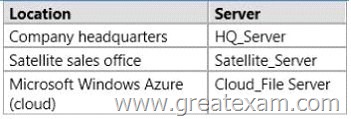
Database
Currently all information is stored in a single database called ProdDB, created with the following script:
The Product table is in the Production schema owned by the ProductionStaff Windows group.
It is the main table in the system so access to information in the Product table should be as fast as possible.
The columns in the Product table are defined as shown in the following table:
The SalesOrderDetail table holds the details about each sale.
It is in the Sales schema owned by the SalesStaff Windows group.
This table is constantly being updated, inserted into, and read.
The columns in the SalesOrderDetail table are defined as shown in the following table:
Database Issues
The current database does not perform well.
Additionally, a recent disk problem caused the system to go down, resulting in lost sales revenue. In reviewing the current system, you found that there are no automated maintenance procedures. The database is severely fragmented, and everyone has read and write access.
Requirements
Database
The database should be configured to maximize uptime and to ensure that very little data is lost in the event of a server failure.
To help with performance, the database needs to be modified so that it can support in-memory data, specifically for the Product table, which the CIO has indicated should be a memory-optimized table. The auto-update statistics option is set off on this database.
Only product managers are allowed to add products or to make changes to the name, description, price, cost, and supplier.
The changes are made in an internal database and pushed to the Product table in ProdDB during system maintenance time. Product managers and others working at the headquarters location also should be able to generate reports that include supplier and cost information.
Customer data access
Customers access the company’s website to order products, so they must be able to read product information such asname, description, and price from the Product table.
When customers place orders, stored procedures calledby the website update product quantity-on-hand values. This means the product table is constantly updated at randomtimes.
Customer support data access
Customer support representatives need to be able to view and not update or change product information. Management does not want the customer support representatives to be able to see the product cost or any supplier information.
Sales force data access
Sales people at both the headquarters office and the satellite office must generate reports that read from the Product and SalesOrderDetail tables.
No updates or inserts are ever made by sales people.
These reports are run at random times and there can be no reporting downtime to refresh the data set except during the monthly maintenance window. The reports that run from the satellite office are process intensive queries with large data sets. Regardless of which office runs a sales force report, the SalesOrderDetail table should only return valid, committed order data; any orders not yet committed should be ignored.
Historical Data
The system should keep historical information about customers who access the site so that sales people can see how frequently customers log in and how long they stay on the site.
The information should be stored in a table called Customer Access.
Supporting this requirement should have minimal impact on production website performance.
Backups
The recovery strategy for Fabrikam needs to include the ability to do point in time restores and minimize the risk of data loss by performing transaction log backups every 15 minutes.
Database Maintenance
The company has defined a maintenance window every month when the server can be unavailable. Any maintenance functions that require exclusive access should be accomplished during that window.
Project milestones completed
– Revoked all existing read and write access to the database, leaving the schema ownership in place.
– Configured an Azure storage container secured with the storage account name MyStorageAccount with the primary access key StorageAccountKey on the cloud file server.
– SQL Server 2014 has been configured on the satellite server and is ready for use.
– On each database server, the fast storage has been assigned to drive letter F:, and the slow storage has been assigned to drive letter D:.
QUESTION 140
Drag and Drop Question
You need to distribute functionality across the three servers.
Which function should you assign to each server? To answer, drag the appropriate functions to the correct servers. Each function may be used once, more than once, or not at all. You may need to drag the split bar between panes or scroll to view content.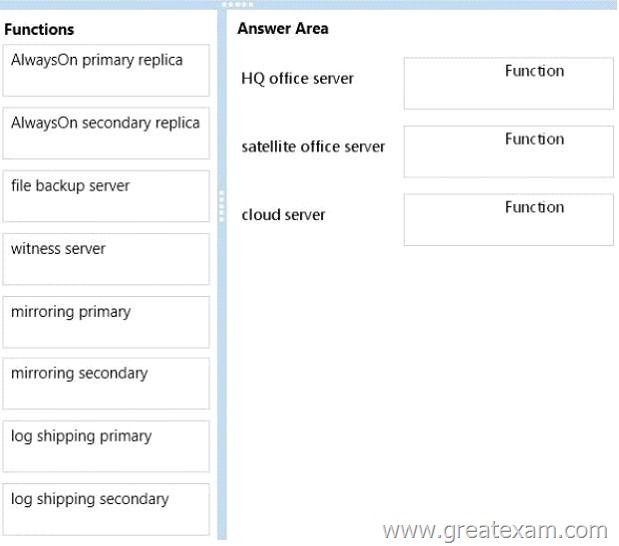
Answer: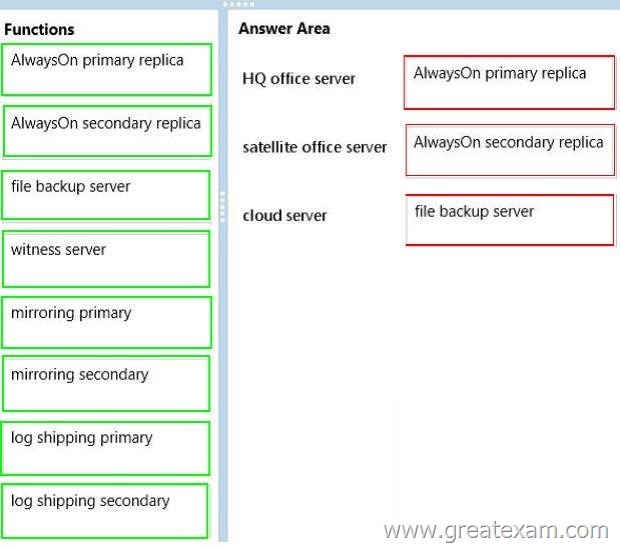
Pass 70-465 exam with the latest GreatExam 70-465 dumps. GreatExam 70-465 exam questions and answers in PDF are prepared by our expert. Moreover, they are based on the recommended syllabus that cover all the 70-465 exam objectives. Comparing with others’, you will find our 70-465 exam questions are more helpful and precise since all the 70-465 exam content is regularly updated and has been checked for accuracy by our team of Microsoft expert professionals. Welcome to choose.